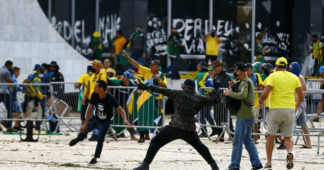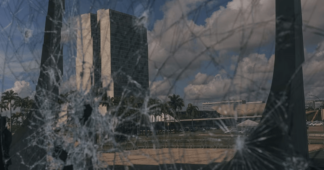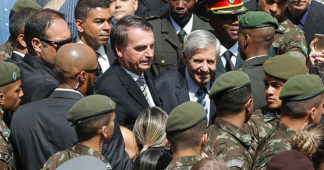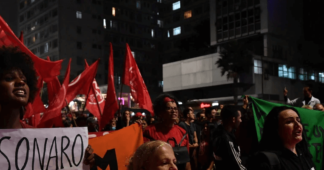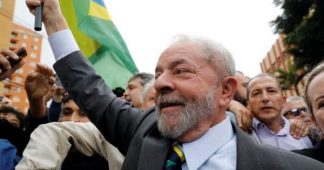On January 8, far-right supporters of former Brazilian president Jair Bolsonaro stormed the seat of Brazil’s government in a scene reminiscent of the US Capitol riot. But President Lula, unlike the US government, is swiftly cracking down on the perpetrators.
By Craig Johnson
Jan 12, 2023
The similarities between their actions and those of Donald Trump’s supporters on January 6, 2021, are inescapable, with both events involving motley crews of right-wing protesters storming federal buildings in a show of support for their losing candidate. But unlike US opponents of Trump, Brazil under President Lula is handling its response to the Plaza invasion very well so far.
The day’s protests began at the nearby army headquarters building, a site of near-continuous demonstrations since Bolsonaro’s loss to Lula as right-wing Brazilians seek to pressure the military to stage a coup on their behalf. The crowd then stormed through barricades and military police who were guarding the Plaza and made their way in through tear gas and pepper spray. After entering the Plaza, they stormed and vandalized the three buildings.
Investigations by the police and journalists into the Brasília Plaza invasion are still ongoing but currently show that the events of January 8 were planned starting last week on WhatsApp and Telegram group chats. This planning enabled the crowd to develop a plan of attack, avoid police intervention until the last minute, and coordinate travel to Brasília — most of the nearly four thousand people who invaded the Plaza arrived in over a hundred chartered buses from around the country, joining several hundred locals who had already been camped at the capitol.
The protesters’ apparent plan was to secure a military intervention in Brazilian politics, and they hoped that their actions would inspire this. (Some of the protesters carried banners reading “military intervention now.”) Early clashes with the police notwithstanding, in the first hours of the invasion it seemed that the police on the Plaza grounds might be sympathetic to the protesters. Video has surfaced of some military police chatting and taking selfies with protesters on the outskirts of the crowd, and some police seemed to act as a kind of escort to the Plaza. President Lula has criticized the Plaza security teams for their early inaction.
Lula Cracks Down
By early evening, however, things had changed. Lula signed off on federal security intervention in the Plaza invasion, putting the federal government in charge of the crackdown. Shortly thereafter, the military police moved in en masse and began to remove the protesters from the buildings, immediately detaining them and transporting them to centers where they are currently being processed and charged with crimes. As of today, over twelve hundred people are to be charged for invading the capitol and property destruction, with the government saying more arrests are likely.
Though the ill-prepared protesters were removed from the scene within a few hours of their invasion, right-wing activity continued on the streets of Brazil. In major cities such as São Paulo, right-wingers blockaded major streets. Protesters were taken to regular detention centers, which right-wing complainers have rather pathetically dubbed “Lulags,” a portmanteau of “gulag” and Lula. Alexandre de Moraes, leader of Brazil’s Supreme Electoral Tribunal, has responded that protesters shouldn’t have expected to be held at a “summer camp” after their arrest. Brazil has also begun investigating and prosecuting the bus and transport companies that arranged for protesters to be bused to the Plaza.
These protests follow months of right-wing backlash by the Right over Lula’s victory and two previous attempted coups by Bolsonaro. The first occurred on September 7, 2021, when Bolsonaro led a group of supporters to invade the Brazilian Supreme Tribunal to seek a change in electoral law that would have boosted his chances of winning the 2022 election. The second attempt occurred on Election Day, as the Highway Police blockaded neighborhoods and detained buses transporting Lula voters in an effort to rig a close election.
The key difference between those events and the capitol invasion this Sunday is that the two earlier efforts stood a chance of succeeding — either could conceivably have kept Bolsonaro in power. This weekend’s Plaza invasion, by comparison, was more an amateurish expression of resentment than a strategic move to change the course of Brazilian politics. Any success in toppling the Lula government would have relied on the cooperation of the security forces in Brasília itself, which Lula quickly federalized.
Bolsonaro Absent
The riot’s failure is in no small part due to Bolsonaro being absent on Sunday. Not only was he not with the protesters — he wasn’t even in the country. Bolsonaro had left Brazil on December 31 for Florida, skipping his successor’s inauguration and likely avoiding arrest, as no longer holding office means that he was vulnerable to prosecution for the first time in his adult life. (He is currently under federal investigation for conspiring with the police to shield his sons from prosecution and spreading lies about Brazil’s elections.)
So, while his overzealous supporters were plotting an attempt to reinstall him as president in absentia, Bolsonaro was enjoying an American vacation, wandering around a Publix grocery store and chowing down on KFC. On Sunday, the former president criticized the rioters for their “destruction and invasion of public buildings.”
The official response to this weekend’s outburst was quick and decisive. The near-unanimous reaction from the federal government recognized the danger posed by the protesters. Lula and his government have emphasized that they aren’t fighting these protesters because of their right-wing politics but because of their attempt to undermine democracy, drawing on the legacy of Brazil’s transition from its long military dictatorship and reminding everyone of the serious threat posed by anyone who advocates for an end to democratic rule. “The coup plotters who promoted the destruction of public property in Brasilia are being identified and will be punished,” Lula tweeted the night after the riots. “Tomorrow we resume work at the Planalto Palace. Democracy always. Goodnight.”
Lula has also been clear that, even though he wasn’t there and didn’t plan Sunday’s Plaza invasion, Bolsonaro was responsible for it. His years of fearmongering, his denial of the election’s results, and his open calls for an end to Brazilian democracy mean that he is culpable for the actions of his supporters. “There are several speeches by the former president of the republic encouraging this,” Lula said. “He encouraged encroachment on the Three Powers whenever he could. And this is also his responsibility and the parties that supported him.”
The Brazilian government is seeking to freeze Bolsonaro’s assets in connection with the attack.
Parallels
Coverage of the Plaza invasion in the United States and other countries’ press made the obvious comparisons between what happened in Brasília this weekend and the invasion of the US Capitol building on January 6, 2021. Both attacks featured the ragtag supporters of a recently ousted right-wing president claiming that they’d had an electoral victory stolen from them, and both involved the destruction of federal property. Both were planned in advance and widely condemned by the international community.
But these comparisons are somewhat shallow. The recent events in Brazil were more a manifestation of inchoate rage than a serious attempt to overthrow the government. The US Capitol invasion was timed and orchestrated to prevent Congress from recognizing Joe Biden’s victory, the last step before his inauguration on January 20. Targeting the Capitol at that moment, and specific politicians vital to the process like former vice president Mike Pence and anti-Trump Republican senator Mitt Romney, made it undeniable that protesters were attempting a coup, even if it was a pitiful attempt. On the other hand, Sunday’s events in Brazil occurred when no politicians were in the building. And while Trump was present in DC on January 6 urging his supporters on, Bolsonaro was thousands of miles away, taking selfies with his American fans.
The biggest difference, though, is in the Brazilian government’s response to the Plaza invasion. Whereas the Brazilian protesters have already been detained, with hundreds of arrests and more to come, in the United States, security forces escorted the rioters out of the building on January 6 and waited before beginning any formal prosecution of the Capitol invaders, even relying on online researchers to identify many of those responsible after allowing them to leave the scene of their crimes.
The Brazilian government isn’t limiting its efforts to the protesters who invaded the Plaza either. For example, a warrant has been issued for Anderson Torres, a former Bolsonaro official who was head of security for the Federal District of Brasília at the time of the Plaza invasion. By contrast, the US government has not addressed the egregious failures of security forces in its own Capitol riot.
This means that many observers have drawn exactly the wrong conclusion, saying that Brazil is a warning for the United States. It’s the opposite — Brazil is swiftly and seriously prosecuting its amateur coup-plotters. Brazil’s major cities saw major street protests condemning the Plaza invasion almost immediately. Meanwhile, the United States has dragged its feet, waiting months to investigate and years to prosecute and only now beginning to grapple with the connection between those who invaded the Capitol on January 6 and the politicians egging them on. The United States, not Brazil, is the cautionary tale of what can happen if a country fails to stand up to threats to democracy.
We remind our readers that publication of articles on our site does not mean that we agree with what is written. Our policy is to publish anything which we consider of interest, so as to assist our readers in forming their opinions. Sometimes we even publish articles with which we totally disagree, since we believe it is important for our readers to be informed on as wide a spectrum of views as possible.
